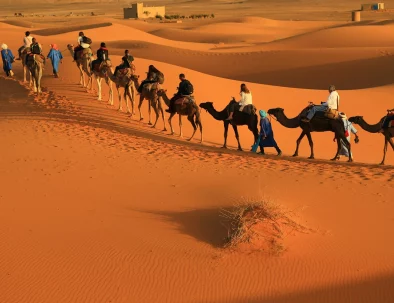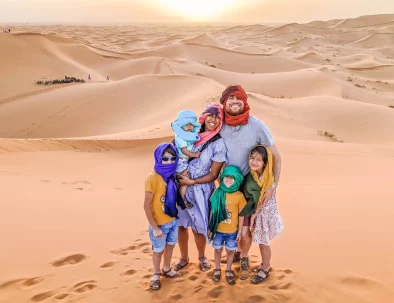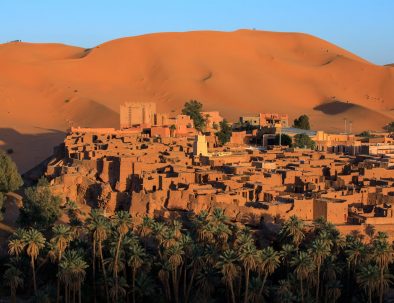1 day: Marrakech – Ouarzazate
At 8.30 in the morning, you will depart from your hotel or riad in Marrakech to drive through the High Atlas Mountains. There will be opportunities to pause and take pictures at panoramic vantage points. The powerful Glaoui tribe, whose wealth was derived partly from the salt mines just outside the village, had its headquarters at the opulent Kasbah of Telouet, where the tour is scheduled to begin. As a result of the last Pasha’s property being seized for conspiring against the King, each addition to the building now stands in ruins, exposed to the wind and rain. Wait until you get to the far end of the Kasbah to be surprised by the authentic interior decor. Green fields and gardens in the Ounila Valley can be seen running parallel to us as we pass. The road winds through numerous bends, surprising travelers with the colors of the rock and soil as it passes by Berber villages, gardens, and smaller Kasbahs. The main crops and sources of income for many families in this region are olives, almonds, and fruit trees. The Kasbah of Ait Ben Haddou, the oldest and most well-known in Morocco and one of the country’s seven UNESCO World Heritage Sites, is accessible via this breathtaking road. The earthen constructions are perfectly adapted to the climatic conditions and in harmony with the surrounding natural and social environment, and the architectural style has been well preserved. Its origins were most likely in the 17th century, and many Hollywood blockbuster movies have used it as their setting. After traveling an additional 30 kilometers, you spend the night in an Ouarzazate riad.
2 day: Ouarzazate – Chegaga Dunes
After breakfast, we drive to Agdez, at the head of the Dra’a Valley, and stop at Kasbah Tamnougalte. A large portion of it is in ruins, particularly the old Jewish neighborhood, as the locals gradually left after the creation of the State of Israel. However, despite how biblical it appears, some areas are still inhabited. Later, you keep going down a side road to lunch in Zagora. You can tour the renowned Tamgroute potteries, which are run by four families and are famous for their distinctive green glaze. Another location worth visiting is a Quranic library containing Qurans and exquisite ancient Arabic manuscripts. We travel 60 km off-road in the 44 to reach the Erg Chegaga dunes. The Sacred Oasis, ‘erg’ (dunes), ‘hammada’ (rocky desert), and dunes far from civilization in the actual desert, where the silence and expanse of sand are overwhelming, are all along this route. You eat dinner and spend the night in an opulent camp with a private bathroom, king-sized beds, lovely Moroccan furnishings, and tastefully placed lamps to enhance your enjoyment of the solitude and beauty of the dunes. The camp also has beautiful Moroccan furnishings.
3 day: Chegaga Dunes – Taroudant
After breakfast, we continue our 90-kilometer journey across the Sahara, crossing the now-dry Lake Iriqui. On the lake’s edge, you can look for fossils. The desert’s edge is where Foum Zguid is located. The town is called “the Mouth of the Zguid River” because the Arabic word “forum” means “mouth.” The road leads us north to Taznakht, known for its carpets and jewelry made by Berber people. You have lunch here. In Taliouine, the center of the saffron-growing region, we arrive after traversing the Tizi-n-Ikhsane and Tizi-nTighatine passes. It is highly recommended to visit the small saffron museum to learn more about the spice’s production. The aroma greets you as you enter. You continue on the road until you reach Taroudant, where you spend the night in a riad.
4 day: Taroudant – Essaouira
You will visit the town known as “the little Marrakech” in the morning. It is fantastic because of its impressive ramparts and lovely medina. You can travel west to Agadir, following the Souss River Valley and its countless indigenous Moroccan argan trees. The nuts’ leaves and “waste” products are valuable animal feed, and argan oil is used cosmetically for the skin and hair. The road then continues along the coast, passing through the surfers’ haven of Taghazout. When you arrive in Essaouira, you can explore the town, the Skala, the medina, its countless shops, and the seafront, which has restaurants serving fresh fish. Essaouira is where you spend the night.
5: Essaouira – Marrakech
Stay in Essaouira after breakfast and eat more fresh fish. Return to Marrakech, perhaps stopping at an argan oil cooperative that sells oil of higher quality and lower cost than that found outside Morocco. You pass through many Berber villages on the way, and you get to Marrakech by late afternoon. Your 5-day Marrakech to Essaouira tour will end as the driver escorts you to your hotel or riad.



